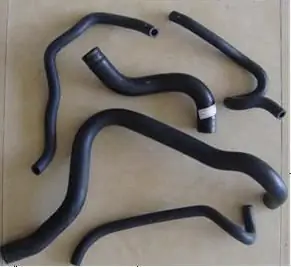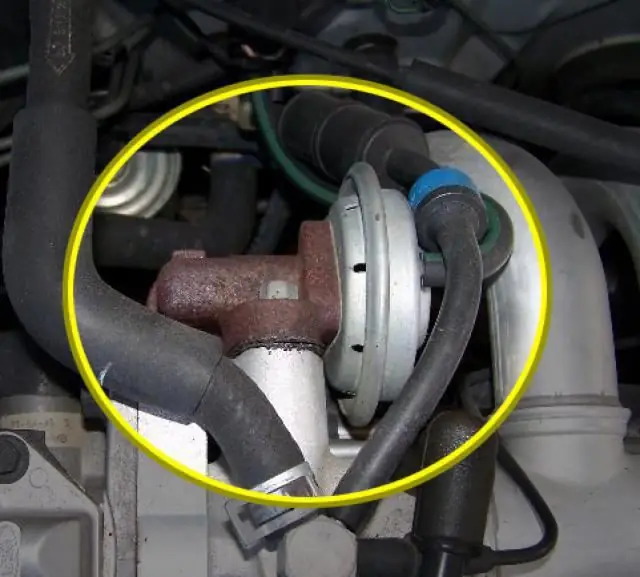2025 Author: Erin Ralphs | [email protected]. Last modified: 2025-01-22 21:14:09
What is an exhaust gas recirculation system? Not every car owner can answer this question, but absolutely all types of modern engines are equipped with this system - from gasoline and diesel to gas. This system plays a very important role in the functioning of the car, so you should definitely understand what it is. And this article will help you with this.

Here you will learn what an exhaust gas recirculation system is, how it functions, what benefits it brings to a car, and also what breakdowns of this system can be and how to avoid them. This information will help you get to know your car better, as well as prevent some unpleasant situations associated with the system, which will now be described in this material.
What is this?
So, what is an exhaust gas recirculation system? Often it is called EGR - this abbreviation comes from the English name of the system, but it is very often used by all Russian-speaking motorists, as it is much more convenient. So what is this mechanism? The exhaust gas recirculation system is responsible forto reduce the level of nitrogen oxides in the exhaust gases. This is achieved by returning part of the gases back to the intake manifold. Naturally, at first glance, all this may seem just rather strange and incomprehensible words, but as you read the article, you will begin to understand more and more what exactly this system does, as well as why the car needs it.
How does it work?
The EGR system functions in a fairly simple manner. The fact is that during the combustion of fuel in the combustion chambers, nitric oxide is formed, which is an incredibly toxic substance. And if it gets into the air along with the exhaust, then the cars will very strongly poison the environment. The higher the temperature in the combustion chamber, the more nitrogen oxide is released, so something needs to be done with this process. This is where the EGR (exhaust gas recirculation) system comes into play - with its help, part of the nitrogen oxide is returned to the intake manifold.
A valve is responsible for the supply of exhaust gases, which opens only when the supply is needed, and closes when the gases have already entered the intake manifold in sufficient quantities. From there, the gases, together with the fuel mixture, enter the combustion chamber, where the mixture is burned, respectively, and the supplied gases reduce the temperature of its combustion.
As you can see, the system is extremely simple, it functions reliably and constantly, so you do not have to worry about the problems that would arise if it were not there. The process of operation of this system is clear and the purpose of its existence, inin general, too. But it’s still worth taking a closer look at exactly what benefits it provides in order to finally realize how important it is to the car.
What does it do?

What does the EGR system actually do? First of all, we are talking about reducing the toxicity of exhaust gases. As mentioned earlier, nitric oxide is extremely toxic, so high levels of it in the exhaust would make cars unusable. And with this system, these toxic gases are used inside the car and do not enter the environment. But this is not the only reason this system functions.
It is also worth paying attention to the fact that incoming re-exhaust gases occupy part of the volume of the combustion chamber, thereby reducing the amount of fuel burned. This results in small savings on the gasoline, diesel, or other fuel you use to move your vehicle. Naturally, the savings are not very large, but still any little things are welcome in this matter. And do not forget that through the use of nitrogen oxides, the EGR system reduces the oxygen content in the fuel mixture, which allows you to effectively deal with the extremely unpleasant knocking phenomenon that happened quite often before the introduction of this system.
Original version
The system first appeared on cars in 1972, howeverthe first experience of using it was a complete failure. The fact is that then the valve was always in the open state, that is, the exhaust gases entered the intake manifold in any mode of engine operation. It would seem that this is bad? But there was a lot of bad in this, since the gases cooled the combustion chamber even when it was not necessary to do this - for example, when the engine warmed up.
Due to the decrease in temperature in the combustion chamber, the engine warmed up much more slowly, which caused dissatisfaction among motorists. Moreover, there was absolutely no control over the supply of gases - even when you need to squeeze the maximum out of the car, that is, to achieve the maximum allowable temperature in the combustion chamber, gas entered there, which reduced the power of the car. That is why the first model of the system turned out to be a failure and was not further developed.
Flaws

Fortunately, another independent Ford EGR system was introduced in the same year, which was much more advanced. It had an automated system for opening and closing valves under specific engine operating conditions. At low temperatures in the combustion chamber, the valve closed, allowing the motorist to calmly warm up the engine. The higher the temperature in the combustion chamber rose, the wider the valve opened, letting in more and more gas for cooling. However, the lack of feed control remained, which led to the fact that the use of this system wasis associated with a number of some disadvantages.
Chief among them was the fact that there was a loss of power due to the fact that the temperature in the combustion chamber always remained optimal and did not allow full power to be voluntarily drawn from the engine. However, at that time, the system was the ultimate dream, and for many years it was she (of course, with some improvements and updates) that was used on all cars. Moreover, you can still find cars that have a similar exhaust gas recirculation system installed - Niva is one of the clearest examples.
Modern Model
However, does the same exhaust gas recirculation system still exist? The Niva and other old-style Russian cars do use it, but in fact the mechanical version has long been outdated and remains on cars only as a relic of the past. In the modern world, electronic systems are used that provide complete control over the operation of the valve. Now the car has an exhaust gas recirculation sensor that monitors both the temperature in the combustion chamber and many other parameters on which the operation of this system depends.
Accordingly, in the modern version of the system, the problem that engine power is reduced when using EGR is completely eliminated. Some of the models of current systems do not use a separate valve for the redistribution of gases at all, since the "brain" of the car controls the valve timing, due to which, respectively,the recycling process is also controlled. Thanks to this approach, the engines were simplified, saving them from unnecessary parts. However, this system is the most modern, so it is not used everywhere and has a high cost. But perhaps in the future it will spread and become more accessible to everyone. And perhaps it will be replaced by another, more advanced system. But this is all speculation - now it is necessary to focus on what is happening here and now. And even better - on what is happening in the conditions of Russian reality.
What is the risk of the exhaust gas recirculation system installed on the VAZ? 21213 is a VAZ-a model that can be equipped with EGR. But is this system really effective in Russia, and not in America or Europe?
EGR in Russian conditions

In theory, this system is an excellent addition to the car - it only benefits and does not portend any trouble at all. And in European conditions, where the fuel is of the highest quality, and people are willing to pay for everything to function well, this is true - EGR shows ideal results and one hundred percent satisfaction among motorists. But what about in Russia? Is everything so different?
It turns out to be more than enough. The fact is that the quality of the fuel that is distributed on the territory of the Russian Federation is much lower than in Western countries, so the recycling system becomes clogged much faster. As a result, this leads tothe exhaust gas recirculation valve fails much faster. You can fix this at a service station, but the cost of replacing the components of this system is quite high, so many Russians refuse to spend extra money on such a system. As a result, they simply muffle it, that is, fix it in one position, preventing its further functioning.
Accordingly, EGR in modern Russian conditions is an actual system only for those who can afford the purchase of high-quality fuel and planned expensive system repairs. The average Russian either cannot afford this or does not want to do it, so more and more people prefer to turn off the exhaust gas recirculation valve, saving themselves unnecessary problems. And here comes a very interesting question. Are they really getting rid of their problems? Or are they just adding more trouble to themselves?
Should I turn off the recycling system?
You already know how the exhaust gas recirculation system works in a car, and you can also imagine what benefits it can bring to a car. However, there is no agreement among motorists on this issue - people are divided into two opposing camps, each of which is sure that they are right. The first camp includes those people who are of the opinion that the recirculation system really works, it reduces emissions, improves engine efficiency and reduces fuel costs.

However, there are also opponents of this idea, who make up the second camp. They prefer to jam the EGR at the first opportunity - this is done quite simply. It is necessary to cut out a gasket from thin tin, which is placed under the system valve, fixing it in one position. As a result, he cannot move and the system stops working.
Many people say that the recirculation system only harms cars, so jamming it will only give positive results. Some suggest experimenting with running your finger along the inside of the exhaust pipe in a car where the EGR system is not working. On your finger you will have a black coating, the main part of which will be soot. It is this, according to such experts, that, along with other contaminants, is fed into the combustion chamber, quickly polluting it and causing engine breakdowns.
There are also those people who belong to the second camp, but do not adhere to such radical views. They also believe that the system can be safely shut down, but only for the reason that it does not bring much benefit to the car, but at the same time, it still requires cleaning and repair in order to function. Therefore, they prefer to jam the system so as not to give out extra money for this very repair.
Breakdowns
If we are talking about malfunctions of the exhaust gas recirculation system, then it is worth taking a closer look at them. What can they be and what consequences can they lead to in the end? There is a large numbervarious options for minor malfunctions, an impressive part of which is associated precisely with the fact that the recirculation system becomes clogged very quickly. This happens during the use of the car, so it is simply impossible to avoid this effect.

If you study the documentation for this system, you can find out that on average it is designed for full operation within 70-100 kilometers. After that, you definitely need to contact the specialists for a planned replacement of spare parts. And, as you already learned earlier, this replacement costs a lot of money, so many people try to avoid it by all means. Especially in Russia, because due to the poor quality of fuel in the country, the service life of such a system is reduced to about fifty thousand kilometers. As a result, if you do not make scheduled repairs, then you may experience certain breakdowns and malfunctions.
One of the most common problems is valve leakage due to prolonged use. As a result, it happens that gases begin to flow in irregular quantities, additional air also enters the intake manifold, which negatively affects how the exhaust gas recirculation system functions. Malfunctions as a result lead to not the most pleasant consequences.
- Firstly, due to the uncontrolled flow of gases and the presence of excess oxygen in the fuel mixture, it becomes depleted. What does it mean? What instead of reducing costsfuel is increased as the fuel mixture becomes less efficient and the engine has to let in even more fuel.
- Secondly, this can lead to the opposite effect - to excessive enrichment of the fuel mixture, as the pressure in the intake manifold will increase significantly.

Depending on the type of system, you can observe either one effect or the other - it is also possible that they will appear alternately. For example, at idle, the mixture will be excessively rich, and when switching between modes, it will become leaner sharply. It’s not even worth telling how harmful it is to the engine and what waste of fuel it leads to. What to do in case of a malfunction?
Repair of the recycling system
If your car already has problems with the exhaust gas recirculation system, then you should definitely contact the specialists who will carry out a comprehensive repair and replacement of the necessary parts for you. As already mentioned above, in European and American conditions, that is, in the presence of high-quality fuel, it will be enough to carry out such maintenance once every hundred thousand kilometers. In Russian conditions, this must be done twice as often, that is, every fifty thousand kilometers.
But what if you don't want to pay for repairs? There are two options, and both can only be used when your system is completely refurbished or new. So the first option is permanent.timely preventive maintenance of the recirculation system. This involves cleaning the key elements of the EGR, that is, the valve itself, as well as the solenoid. The valve must be cleaned so that it does not leave any marks that would interfere with its tight closure.
As for the solenoid, it has a tiny filter that you need to pay attention to. This is what you need to clean so that it continues to protect the vacuum system from various types of contamination.
The second option, which has already been mentioned earlier, is to jam the recirculation system.
Recommended:
How does an automobile membrane tank (expansion tank) work and what functions does it perform?

Oddly enough, on the Internet you can find thousands of articles about thermostats and radiators, but few people remember such an important detail in the cooling system as a membrane expansion tank. It has a visually simple design and primitive functions, but its presence is very significant for every car. Often, motorists have come across cases when the internal combustion engine temperature sensor gives exorbitant values. But few thought about the reasons
How does the EGR valve work?

Few people know, but it is precisely thanks to exhaust gas recirculation that it is possible to significantly reduce the fuel consumption of a car, increase engine performance, normalize its operation and reduce detonation. There is such a system for a long time, and at the moment it is used on absolutely all vehicles. Even on the domestic "Niva" there is such a device
Cooling system device. Branch pipes of the cooling system. Replacing the pipes of the cooling system

The internal combustion engine works stably only under a certain thermal regime. Too low a temperature leads to rapid wear, and an excessively high temperature can cause irreversible consequences, up to jamming of the pistons in the cylinders. Excess heat from the power unit is removed by the cooling system, which can be liquid or air
How does the exhaust system work?

The exhaust system is designed to remove combustion products from the engine and discharge them into the environment. At the same time, noise pollution should be reduced to acceptable limits
Ford Focus-2 trunk does not open. How to independently open the fifth door and make repairs. How much does it cost to work in a service center

"Ford Focus-2" has received wide popularity not only in the Russian market, but also in European countries, in the US, China and India. Motorists are happy to buy sedans, hatchbacks, station wagons from Ford because of their reliability, ease of repair and comfortable suspension. However, with a mileage of more than 100,000 kilometers, the following malfunction often occurs: the trunk of the Ford Focus-2 does not open. The problem manifests itself unexpectedly and is noticed both on restyled and pre-styling models

